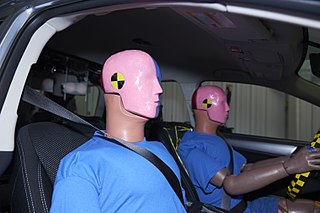
The sound barrier or sonic barrier is the large increase in aerodynamic drag and other undesirable effects experienced by an aircraft or other object when it approaches the speed of sound. When aircraft first approached the speed of sound, these effects were seen as constituting a barrier, making faster speeds very difficult or impossible. The term sound barrier is still sometimes used today to refer to aircraft approaching supersonic flight in this high drag regime. Flying faster than sound produces a sonic boom.

A crash test dummy, or simply dummy, is a full-scale anthropomorphic test device (ATD) that simulates the dimensions, weight proportions and articulation of the human body during a traffic collision. Dummies are used by researchers, automobile and aircraft manufacturers to predict the injuries a person might sustain in a crash. Modern dummies are usually instrumented to record data such as velocity of impact, crushing force, bending, folding, or torque of the body, and deceleration rates during a collision.

Crash Test Dummies are a Canadian rock band from Winnipeg, Manitoba.

A barrage balloon is a type of airborne barrage, a large uncrewed tethered balloon used to defend ground targets against aircraft attack, by raising aloft steel cables which pose to hostile aircraft a severe risk of collision, making the attacker's approach difficult and hazardous. Early barrage balloons were often spherical. The kite balloon, having a shape and cable bridling which stabilises the balloon and reduces drag, could be operated at higher wind speeds than could a spherical balloon. Some examples carried small explosive charges that would be pulled up against the aircraft to ensure its destruction. Barrage balloons are not practical against high-altitude aircraft. The long cable required for a high-altitude balloon would be too heavy.

Saturn-Apollo 3 (SA-3) was the third flight of the Saturn I launch vehicle, the second flight of Project Highwater, and part of the American Apollo program. The rocket was launched on November 16, 1962, from Cape Canaveral, Florida.

A strain gauge is a device used to measure strain on an object. Invented by Edward E. Simmons and Arthur C. Ruge in 1938, the most common type of strain gauge consists of an insulating flexible backing which supports a metallic foil pattern. The gauge is attached to the object by a suitable adhesive, such as cyanoacrylate. As the object is deformed, the foil is deformed, causing its electrical resistance to change. This resistance change, usually measured using a Wheatstone bridge, is related to the strain by the quantity known as the gauge factor.
The Saturn I was a rocket designed as the United States' first medium lift launch vehicle for up to 20,000-pound (9,100 kg) low Earth orbit payloads. The rocket's first stage was built as a cluster of propellant tanks engineered from older rocket tank designs, leading critics to jokingly refer to it as "Cluster's Last Stand". Its development was taken over from the Advanced Research Projects Agency in 1958 by the newly formed civilian NASA. Its design proved sound and flexible. It was successful in initiating the development of liquid hydrogen-fueled rocket propulsion, launching the Pegasus satellites, and flight verification of the Apollo command and service module launch phase aerodynamics. Ten Saturn I rockets were flown before it was replaced by the heavy lift derivative Saturn IB, which used a larger, higher total impulse second stage and an improved guidance and control system. It also led the way to development of the super-heavy lift Saturn V which carried the first men to landings on the Moon in the Apollo program.

Project Excelsior was a series of parachute jumps made by Joseph Kittinger of the United States Air Force in 1959 and 1960 from helium balloons in the stratosphere. The purpose was to test the Beaupre multi-stage parachute system intended to be used by pilots ejecting from high altitude. In one of these jumps Kittinger set world records for the longest parachute drogue fall, the highest parachute jump, and the fastest speed by a human through the atmosphere. He held the latter two of these records for 52 years, until they were broken by Felix Baumgartner of the Red Bull Stratos project in 2012, though he still holds the world record for longest time in free fall.

I Don't Care That You Don't Mind is the fifth studio album by Crash Test Dummies. The album began as a solo album for Brad Roberts, while he was recuperating in the town of Argyle, Nova Scotia after suffering a near-fatal car accident in September 2000. Crash Test Dummies' name was put on the album after the band agreed to tour the album.

The JIM suit is an atmospheric diving suit (ADS), which is designed to maintain an interior pressure of one atmosphere despite exterior pressures, eliminating the majority of physiological dangers associated with deep diving. Because there is no need for special gas mixtures, nor is there danger of nitrogen narcosis or decompression sickness ; the occupant does not need to decompress when returning to the surface. It was invented in 1969 by Mike Humphrey and Mike Borrow, partners in the English firm Underwater Marine Equipment Ltd (UMEL), assisted by Joseph Salim Peress, whose Tritonia diving suit acted as their main inspiration. The suit was named after Jim Jarrett, Peress' chief diver.
The VLS-1 was the Brazilian Space Agency's main satellite launch vehicle. The launch vehicle was to be capable of launching satellites into orbit. The launch site was located at the Alcântara Launch Center due to its proximity to the equator.

Similar to skydiving, space diving is the act of jumping from an aircraft or spacecraft in near space and falling towards Earth. The Kármán line is a common definition as to where space begins, 100 km (62 mi) above sea level. This definition is accepted by the Fédération Aéronautique Internationale (FAI), which is an international standard setting and record-keeping body for aeronautics and astronautics. The United States Air Force uses 50 mi (80 km) to award astronaut wings.

SpaceAge Control is a design, manufacturing, and service company focused on 3D displacement sensing and measurement.

COMEX is a French company specializing in engineering and deep diving operations, created in November 1961 by Henri-Germain Delauze and ran by him until his death in 2012.
Louis Francis Langhurst was an American engineer and inventor. Born in Cedar Rapids, Iowa, he is best known for building a 7/10-scale flying replica of Germany's feared Junkers Ju 87 Stuka dive-bomber.

The following outline is provided as an overview of and topical guide to underwater diving:

The following index is provided as an overview of and topical guide to underwater diving:
Diving support equipment is the equipment used to facilitate a diving operation. It is either not taken into the water during the dive, such as the gas panel and compressor, or is not integral to the actual diving, being there to make the dive easier or safer, such as a surface decompression chamber. Some equipment, like a diving stage, is not easily categorised as diving or support equipment, and may be considered as either.
Humanetics is a Digital Industrial Technology company, and a leading provider of safety systems, anthropomorphic test devices, crash test equipment, simulation software, CAE models, precision sensors, fiber optics and cutting-edge laser material engineering solutions.

DTS (Diversified Technical Systems) is an American manufacturer of miniature, rugged, data acquisition systems and sensors for product and safety testing in extreme environments. DTS products, made in the U.S., are used in multiple industries including automotive, aerospace, military and defense, industrial, and sports and injury biomechanics. DTS was founded in 1990 by three crash test engineers: Mike Beckage, Steve Pruitt, and Tim Kippen. The company is headquartered in Seal Beach, California, with technical centers in Michigan, Europe, Japan, China, Korea, and Asia Pacific.












